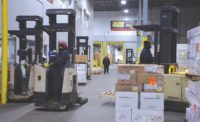The final FDA rules on food safety are here and functioning. Developed over the last 11 years, the rules establish requirements for those bound by them to ensure the safety of food products that move through the supply chain. Those required to comply include shippers who ship food to the United States from Canada and/or Mexico by motor or rail vehicle, vessel or air carriage and arrange for the transfer of the food product to motor or rail vehicle for further consumption or distribution in the United States.
Specifically, the Food Safety Modernization Act (FSMA) establishes requirements for vehicles and transportation equipment, transportation operations, records, training and waivers. Certain key requirements demand new approaches to control, but there are only two firms currently providing logistics support for three specific key requirements—vehicles and transportation equipment, transportation operations and records. There is one additional area that’s an exception to the FSMA key requirements. That specific area covers exporters who ship food through the United States not intended to enter distribution within the United States.
How to meet key requirements
Transportation vehicles and equipment. Transportation vehicles and equipment applies to motor, rail, sea or air service, regardless if the food enters U.S. interstate commerce or not. The equipment used to transport food, and some FDA drug products, must not allow for spoilage or adulteration “during transport.” Complying with the concept “during transport” is important since it would require monitoring from origin to destination. That monitoring would also require container security devices (CSD) in the container or trailer to detect an unauthorized entry into the conveyance, which could indicate a loss of temperature needed for the contents, or an entry to add other food products or even counterfeit goods. Therefore, the conveyance must have the appropriate internal temperature hardware and CSDs to detect and notify the responsible party—the shipper, carrier or loader.
Transport operations. Transport operations begin with the identification and loading of the food product into the conveyance at origin. This can be the responsibility of either the shipper, carrier, loader or exporter depending on the contractual agreements that assign some these responsibilities to other parties. Without a contractual agreement, however, the shipper has the ultimate responsibility. Therefore, the responsible party for the food’s movement would need to verify at loading the cargo and its quantity as well as ensure the use of an appropriate CSD to detect any unauthorized opening or temperature loss if carried in the refrigerated sealed container. These transportation operations require that the food must be carried in a “completely enclosed” container and be “shelf stable,” or safely stored at room temperature in a sealed container.
Records. Keeping records include being able to provide the written procedures used in the shipment by the appropriate entity responsible for the shipment and carriage of the food product. The records that cover the activity of loading and transporting the shipment must be maintained for at least 12 months, and demonstrate that the appropriate entity responsible for the movement meets all the requirements of the FSMA rules. This would be exceptionally difficult to provide for those shipments entering the United States for transit in or through the United States for destinations in other foreign nations.
The importer/exporter problem. The rules specifically say that shippers who ship food to the United States from Canada or Mexico by motor or rail vehicle, ship or air, whether or not the food is offered for or enters interstate commerce, and arrange for the transfer of the intact container onto a motor or rail vehicle for transportation within the United States and will be consumed or distributed in the United States, are subject to the rules. This is an area in the final rules that opens the door to the entry of unsanitary or dangerous food into the United States. Companies that transport food intended for export are covered by the rule until the shipment reaches a port or U.S. border. This is a very confusing treatment because it lacks the detail necessary in discussing these types of sales.
How to comply with these requirements
Transport vehicles and equipment. This key requirement may be the easiest one to which to conform, since the top food conveyances manufacturers and carriers use appropriate containers now. All they need to do is employ the new chain-of-custody process of cargo verification and monitoring from origin to destination, and employ the appropriate CSD for that conveyance. The use of both the CSD and chain-of-custody process provides the following benefits from origin to destination:
- Any access to this sealed conveyance.
- Any loss of compressed food gases such as carbon dioxide, nitrogen or oxygen authorized for use in certain good and beverage products.
- Any off-course deviation from a designated pre-determined course of travel.
- Any change in temperature or internal environment in the container.
- Where it is at any given time in its movement from origin to destination.
- The identification number of the conveyance.
- The actual description of the food cargo and its quantity.
- Use of a system that identifies the person authorized to confirm the cargo and its quantity.
Transport operations. Transport operations may be addressed in numerous ways, but they must always specify who is responsible for the movement of the food or food-linked products. The new rules have added a “loader” to the list. A loader is a person who physically loads food into a motor or rail vehicle. The loader has been added as a covered party, having the responsibility to load the conveyance and be identified as the person who physically confirms that the appropriate food products are enclosed, that the transport equipment is appropriate for that specific food product being transported and that the conveyance temperature system is accurately prepared for the container’s movement. The proper shipper, carrier and loader must be established by contractual agreement for any given shipment. The rules allow the shipper to rely on contractual agreements to assign some of these responsibilities to other parties.
Records. Today, this is probably the easiest aspect to control and fully meet the new FSMA rule requirements. This can be done by utilizing the chain-of-custody process in these freight movements. This process automatically identifies the agent loading or verifying the cargo’s identification, its quantity, the container’s ID number and specified other logistics data such as the manifest or bill of lading. It also identifies the person arming the CSD and sealing the conveyance. At that point, the control center of the firm providing the CSD begins to receive all the data of the shipment’s movement from origin to destination, including any off-course variance if required by the user, any entry into the conveyance and where it took place, any change in temperature or internal environment and the automatic submission of that movement’s data to appropriate stakeholders even to include government agencies. In effect, the control center communicating with CSD has an electronic file of the entire movement, which serves as a legal audit of the shipment’s transportation and can be stored for any number of years, normally 5 years for customs and border protection requirements.
The importer/exporter factor. Perhaps this area of the rules is the most confusing because the rules do not contain language normally used in international business activities involving importers and exporters. For instance, the rules use the word persons, e.g., shippers in other countries who ship food to the United States. Those persons or shippers are still “exporters.” However, the rule limits the use of exporter only to those companies involved in the transportation of food intended for export. But, to make it more confusing, it says the person is covered only until the shipment reaches a port or U.S. border. The rule doesn’t say cross the border or be exported. It appears that the rules in this area were written by those without experience in international sales and transportation. As the rule is written, the shipment could be altered or sold at the border or before getting to the border. How would our government agencies know? Or how would a Canadian exporter who is responsible for that particular shipment know what took place at the border? What if it reaches the border where there is no international port of entry? Then I assume it is no longer covered and can be sold before crossing the border. Technically, these types of shipments transported through the United States but not permitted to enter the commerce of the United States are called “in-bond” shipments and must conform to CBP regulations. Unfortunately, customs and border protection has no way of knowing if the conveyance has been breached and goods removed or goods are added.
All these compliance issues can be fixed, however. Those responsible for any type of food shipment whether imported, exported, in-bond or domestic, can protect themselves by using an appropriate CSD and chain-of-custody.



